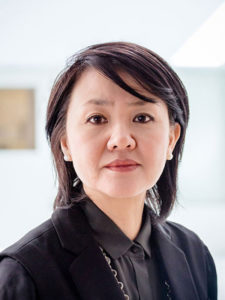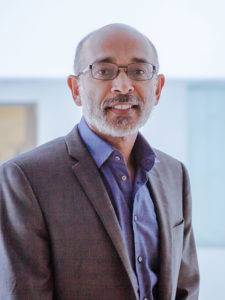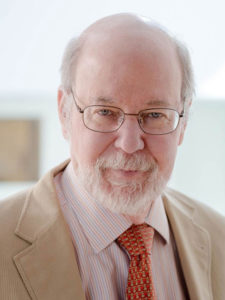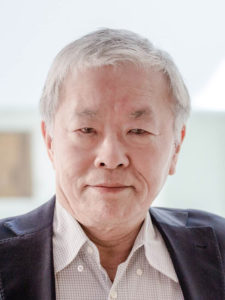Battling Alzheimer’s with light and sound
Battling Alzheimer’s with light and sound
Keeping Aging Brains Healthy
Battling Alzheimer’s with light and sound
By understanding how brain function changes with age, we can develop therapies to improve brain health and eradicate diseases like Alzheimer’s.
This is a global challenge. Dementias of aging now claim 46 million people worldwide, with the numbers poised to double every 20 years. The annual cost – now estimated at $604 billion – is growing faster than the number of sufferers. In the United States alone, care for Alzheimer's patients is estimated to total $1.1 trillion by 2050.
The Aging Brain Initiative is an interdisciplinary effort combining faculty expertise, knowledge, and technical resources from across MIT to solve the mysteries of the aging brain. MIT scientists are opening doors to an entirely new direction of brain research, building new tools to address the challenges of brain aging, and creating a better future for millions.
Highlights
On the Same Wavelength
On the Same Wavelength
Retraining brainwaves with flickers to reverse damage. MIT scientists investigate ways to reverse the affects of Alzheimer's and other diseases of the aging brain. Directed by Sarah Klein & Tom Mason of Redglass Pictures for the MIT School of Science. 2020.
Your browser does not support video embeds, please follow the link below to watch the video.
https://www.youtube.com/embed/_vmUZZjN-WI?feature=oembed&controls=1&hd=1&autohide=1&showinfo=0&modestbranding=1&rel=0&color=whiteMemory organization
Memory organization
“Event” Cells in the Brain Help Organize Memory into Meaningful Segments
More often memory segments what we experience into a string of discrete, connected events. A new study by neuroscientist Susumu Tonegawa of the Massachusetts Institute of Technology and his colleagues claims to have discovered the neural processing that makes this organization of memory into discrete units possible. The work has implications for understanding how humans generalize knowledge, and it could aid efforts to develop AI systems that learn faster.
GENUS: Research to determine whether sensory stimulation can combat Alzheimer's disease
GENUS: Research to determine whether sensory stimulation can combat Alzheimer's disease
MIT neuroscientists in the lab of Professor Li-Huei Tsai at The Picower Institute for Learning and Memory are studying whether sensory stimulation -- light and/or sound -- can reduce Alzheimer's disease pathology and improve memory by increasing the power of gamma rhythms in the brain. Two papers in 2019 reported encouraging results in multiple mouse models of the disease. Research is getting underway with human volunteers.
Your browser does not support video embeds, please follow the link below to watch the video.
https://www.youtube.com/embed/2W4ZdXOSXiI?feature=oembed&controls=1&hd=1&autohide=1&showinfo=0&modestbranding=1&rel=0&color=whiteNon-Invasive Treatment
Non-Invasive Treatment
An Hour of Light and Sound a Day Might Keep Alzheimer’s at Bay
"This is the first time we’ve seen that this noninvasive stimulation can improve cognitive function. It’s not a drug or an antibody or anything, it’s just light and sound.”
Brain mapping
A comprehensive map of how Alzheimer’s affects the brain
Brain mapping

“We wanted to know if we could distinguish whether each cell type has differential gene expression patterns between healthy and diseased brain tissue,” said Li-Huei Tsai, director of MIT’s Picower Institute for Learning and Memory. “This is the power of single-cell-level analysis: You have the resolution to really see the differences among all the different cell types in the brain.” The most surprising finding, the researchers say, was the discovery of a dramatic difference between brain cells from male and female Alzheimer’s patients.
APOE4 gene and higher risk
Neuroscientists discover roles of gene linked to Alzheimer’s
APOE4 gene and higher risk
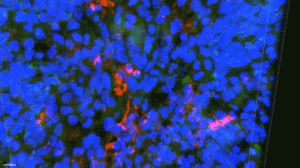
APOE4 is three times more common among Alzheimer’s patients than it is among the general population, which has the common form of the gene, APOE3. Researchers found that APOE4 promotes the accumulation of the beta amyloid proteins that cause the characteristic plaques seen in the brains of Alzheimer’s patients. The researchers also found that they could eliminate the signs of Alzheimer’s in brain cells with APOE4 by editing the gene with CRISPR to turn it into the APOE3 variant.
Mouse Disco
Mouse Disco
How light and noise might banish Alzheimer’s, improve memory, and more
A growing body of evidence, including Aging Brain Director Li-Huei Tsai’s findings, hint at a meaningful connection between modulating brainwaves and affecting neurological disorders such as Alzheimer’s and Parkinson’s diseases. The work offers the possibility of forestalling or even reversing the damage caused by such conditions without using a drug.
Memory Formation Theory
Revising models of memory formation
Memory Formation Theory
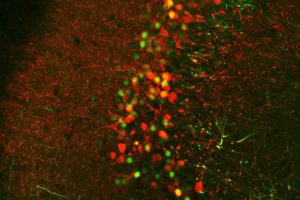
In a study of mice with symptoms that mimic early Alzheimer’s disease, researchers found that while the mice had trouble recalling memories, those memories still existed and could be optogenetically retrieved for up to eight days. This study suggests that re-activating certain synapses could help restore some memory recall function in patients with early stage Alzheimer’s disease.
High-resolution imaging
Mapping brain circuits
High-resolution imaging
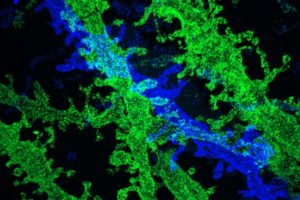
MIT researchers have developed a way to make extremely high-resolution images of tissue samples, at a fraction of the cost of other techniques that offer similar resolution. The resolution allows scientists to see the proteins that cluster together in complex patterns at brain synapses, helping neurons to communicate with each other.
An Effective Treatment for Alzheimer's?
Restoring Brain Function
An Effective Treatment for Alzheimer's?
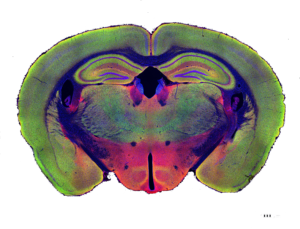
With 40-hertz light therapy, Alzheimer’s patients may one day be able to treat themselves—perhaps wearing a special headset that emits the flickering light. Here, we see a slice of a mouse brain exposed to light therapy causing a reversal of severe neurodegeneration.
The Team
News
-
40 Hz vibrations reduce Alzheimer’s pathology, symptoms in mouse models
June 5, 2023
-
Aging Brain Initiative awards fund five new ideas to study, fight neurodegeneration
April 28, 2022
-
Memory-making involves extensive DNA breaking
July 14, 2021
-
Neuroscientists discover a molecular mechanism that allows memories to form
October 5, 2020
-
Study finds path for addressing Alzheimer’s blood-brain barrier impairment
June 8, 2020
-
Light and sound stimulus therapy generates a buzz in Alzheimer’s research world
March 15, 2019
-
MIT researchers uncover more data on gene variant link to Alzheimer's
May 31, 2018
-
How flashing lights and pink noise might banish Alzheimer’s, improve memory and more
February 28, 2018
-
The End of Alzheimer’s?
November 27, 2017
-
Cellular reprograming implicated in model of Alzheimer’s disease
October 12, 2017
-
LED Lights May Be a Promising New Alzheimer’s Treatment, MIT Study Says
December 7, 2016
-
Could an MIT team’s discovery one day restore the memories of Alzheimer’s patients?
August 8, 2017
-
Bringing Gamma Back
December 8, 2016
To make a gift to the Aging Brain Initiative, please contact Asha Bhakar or Elizabeth Chadis.
